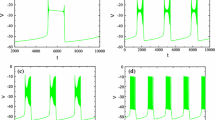Abstract
Neuronal networks control motor output through multi-rhythmic electrical activities with different frequencies and amplitudes of different neurons. For example, the pre-Bötzinger complex related to respiratory function exhibits sigh (slow frequency and large amplitude) and eupnea (fast frequency and small amplitude) rhythms. In the present paper, rhythm transitions modulated by several physiological factors are simulated in a coupling model composed of sigh and eupnea compartments, and the roles of ionic currents and the underlying bifurcation mechanism of the rhythm transitions are acquired. The transition from sigh- and eupnea-rhythm to the eupnea rhythm induced by the blockage of calcium or hyperpolarization-activated channels is related to supercritical Hopf bifurcation of the sigh compartment, and to the sigh rhythm caused by the blockage of persistent sodium channel or change of extracellular potassium concentration is associated with subcritical Hopf/fold limit cycle bifurcation of the eupnea compartment. The parameter regions of ionic currents and dynamical mechanism of rhythm transitions in the pre-Bötzinger complex are helpful for the modulation to the respiratory rhythms.





Similar content being viewed by others
References
A. Shaffer, R. Follmann, A.L. Harris, S. Postnova, H. Braun, E.R. Jr, Eur Phys J Spec Top. 226, 1939 (2017). https://doi.org/10.1140/epjst/e2017-70024-6
Y. Li, B. Jia, X. Zhang, Y. Yang, Eur Phys J Spec Top. 227, 821 (2018). https://doi.org/10.1140/epjst/e2018-800006-2
Y. Zhang, Y. Xu, Z. Yao, J. Ma, Nonlinear Dyn. 102, 1849 (2020). https://doi.org/10.1007/s11071-020-05991-y
H. Hua, B. Lu, H. Gu, Acta Phys Sin. 69, 090502 (2020). https://doi.org/10.7498/aps.69.20191709
P. Meyrand, J. Simmers, M. Moulins, Nature. 351, 60 (1991). https://doi.org/10.1038/351060a0
P. Dickinson, C. Mecsas, E. Marder, Nature. 344, 155 (1990). https://doi.org/10.1038/344155a0
W. Stein, J Comp Physiol A. 195, 989 (2009). https://doi.org/10.1007/s00359-009-0483-y
P. Li, W. Janczewski, K. Yackle, K. Kam, S. Pagliardini, M.A. Krasnow, Nature. 530, 293 (2016). https://doi.org/10.1038/nature16964
M. Chevalier, N. Toporikova, J. Simmers, M. Thoby-Brisson, eLife. 5, e16125 (2016) doi: https://doi.org/10.7554/eLife.16125
B.J. Bacak, T. Kim, J.C. Smith, J.E. Rubin, I.A. Rybak, eLife. 5, e13403 (2016) doi: https://doi.org/10.7554/eLife.13403
H. Koizumi, J.C. Smith, J Neurosci. 28, 1773 (2008). https://doi.org/10.1523/jneurosci.3916-07.2008
R.W. Pace, D.D. Mackay, J.L. Feldman, C.A.D. Negro, J Physiol. 580, 485 (2007). https://doi.org/10.1113/jphysiol.2006.124602
R.W. Pace, D.D. Mackay, J.L. Feldman, C.A.D. Negro, J Physiol. 582, 113 (2007). https://doi.org/10.1113/jphysiol.2007.133660
C.A.D. Nnegro, C. Morgado-Valle, J.A. Hayes, D.D. Mackay, R.W. Pace, E.A. Crowder, J.L. Feldman, J Neurosci. 25, 446 (2005). https://doi.org/10.1523/jneurosci.2237-04.2005
L. Beltran-Parrazal, J. Fernandez-Ruiz, R. Toledo, J. Manzo, C. Morgado-Valle, Neuroscience. 224, 116 (2012). https://doi.org/10.1016/j.neuroscience.2012.08.016
N. Toporikova, M. Chevalier, M. Thoby-Brisson, eNeuro. 2, 2 (2015) doi: https://doi.org/10.1523/eneuro.0074-14.2015
L. Duan, J. Liu, X. Chen, P. Xiao, Y. Zhao, Cogn Neurodyn. 11, 91 (2017). https://doi.org/10.1007/s11571-016-9411-3
Y.X. Yang, Y.Y. Li, H.G. Gu, Acta Phys Sin. 69, 040501 (2020). https://doi.org/10.7498/aps.69.20191509
N. Toporikova, R.J. Butera, J Comput Neurosci. 30, 515 (2011). https://doi.org/10.1007/s10827-010-0274-z
B. Jia, H. Gu, Int J Bifurcat Chaos 27, 1750113 (2017). https://doi.org/10.1142/S0218127417501139
H. Gu, B. Pan, G. Chen, L. Duan, Nonlinear Dyn. 78, 391 (2014). https://doi.org/10.1007/s11071-014-1447-5
Y. Yang, Y. Cui, K. Sang, Y. Dong, Z. Ni, S. Ma, H. Hu, Nature. 554, 317 (2018). https://doi.org/10.1038/nature25509
Z. Faghani, S. Jafari, C.Y. Chen, F. Nazarimehr, Eur Phys J B. 93, 216 (2020). https://doi.org/10.1140/epjb/e2020-10477-6
K. Rajagopal, F. Nazarimehr, A. Karthikeyan, A. Alsaedi, T. Hayat, V.T. Pham, Frontiers Inf Technol Electronic Eng. 20, 584 (2019). https://doi.org/10.1631/fitee.1800389
N. Zandi-Mehran, S. Jafari, S.M. Golpayegani, F. Nazarimehr, M. Perc, Nonlinear Dyn. 100, 11s (2020). https://doi.org/10.1007/s11071-020-05576-9
H. Hua, H. Gu, Y. Jia, B. Lu, Commun Nonlinear Sci. 110, 106370 (2022). https://doi.org/10.1016/j.cnsns.2022.106370
B. Ermentrout, Simulating, analyzing, and animating dynamical systems: A guide to XPPAUT for researchers and students (SIAM, Philadelphia, 2002)
Funding
This work was supported by the National Natural Science Foundation of China (Grant Nos. 11872276 and 12072236).
Author information
Authors and Affiliations
Contributions
Huaguang Gu made contributions to the acquisition and supervision of funds and participated in investigation and writing and review. Hongtao Hua simulated the model, analyzed the bifurcations, and wrote the first draft.
Corresponding author
Ethics declarations
Conflict of interest
The authors declare that they have no known competing financial interests or personal relationships that could have appeared to influence the work reported in this paper.
Rights and permissions
About this article
Cite this article
Hua, H., Gu, H. Bifurcations underlying sigh and eupnea rhythmic transition in a pre-Bötzinger complex model. Eur. Phys. J. Spec. Top. 231, 4109–4116 (2022). https://doi.org/10.1140/epjs/s11734-022-00631-5
Received:
Accepted:
Published:
Issue Date:
DOI: https://doi.org/10.1140/epjs/s11734-022-00631-5




